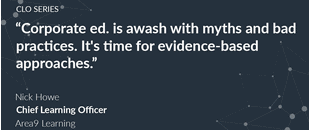Cognota® has recently kicked off a series of interviews with current and former Chief Learning Officers and senior learning professionals. We are pleased to share the results here in our blog.
We recently were fortunate enough to catch up with Nick Howe, CLO of Area9, former Vice President of Learning and Development at Hitachi Data Systems, and Board Advisor to Cognota®. This blogpost incorporates his responses to questions related to the challenges of designing learning systems, taking advantage of trends, and measuring ROI. 
“Some of the biggest challenges when designing learning relate to understanding the needs of the business,” begins Howe. “We constantly have to ask: what problem we are trying to solve, and can learning make a difference?”
Next comes resources. When designing and developing learning, Howe explains that he and his team use a blend of in-house and contract resources to deliver flexibility and stay on budget. But flexibility can become a challenge when working with subject matter experts (SMEs). Access to SMEs can be very difficult — developing training is generally not their number one priority — and can extend development timelines by a factor of two or more.
Learning professionals are also challenged when there is a lack of stability in the content, especially for new product introductions. “It is really difficult to develop training and meet deadlines when the underlying material is in flux,” says Howe.
“Once we have a clear business goal, have access to resources, and can pull the right content together at the right time, our job isn’t done,” he cautions. “Creating learning that sticks isn’t easy.”
“We fool ourselves that one-time, event-based learning makes a sustained difference in performance,” admits Howe. “Learning needs to be spaced and repeated, and that is difficult to achieve in a demanding work environment.”
Beyond that, Howe points to the global audience and heterogeneous nature of today’s workplace as further complications. Compromising around language and diagnosing the different needs of these learners are continuing challenges for learning and development leaders.
Howe admits that he and his team do not measure ROI in financial terms. “That’s a fool’s errand, in my opinion,” he says. Impact is measured in other ways, including proficiency measures against targets agreed with the business, and anecdotal evidence of business impact as a result of training. On the customer side, they measure adoption.
On a positive note, the learning industry is moving forward quickly. To stay on top of industry trends, Howe and his team attend conferences. With so many events to choose from, they divide and conquer. “I set strong expectations from the team, that if we aren’t moving forward, we are moving backwards,” he says.
“Corporate ed. is awash with myths and bad practices. It’s time for evidence-based approaches.”
Howe went on to discuss future trends he sees in learning and development. Technologies will advance, especially those related to mobile and augmented reality, which can provide the possibility of real-time performance support in a variety of work situations.
Adaptive learning will also be a trend. “‘Dumb’ eLearning needs to be consigned to the trash can,” suggests Howe. “It wastes millions of hours of workers’ time and is relatively ineffective. Gamification is a band aid to drive attention. True personalization of learning is the key.”
Often, innovations like adaptive learning require new learning software, and that isn’t always easy. “Corporate training systems are never the top priority of IT departments,” says Howe. “There’s no sense of urgency among corporate IT to implement innovative training solutions, though with SaaS applications, learning leaders are most likely finding workarounds to develop and deliver content to their learners, and to make a difference.
Taking advantage of rapidly shifting changes in corporate learning and development “needs a culture where innovation is expected,” says Howe. Today’s learning leaders should willingly embrace change and work to bridge the divide between existing skills and the needs of the business.




